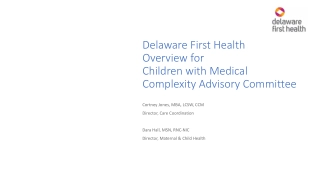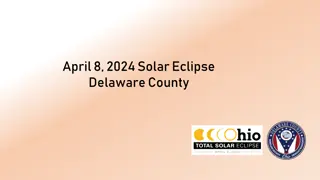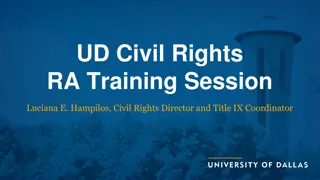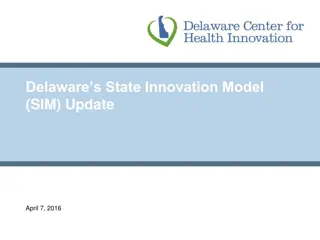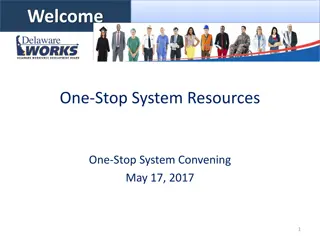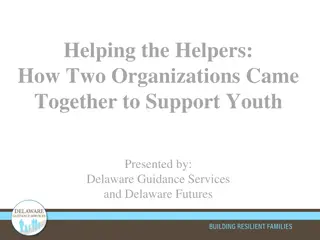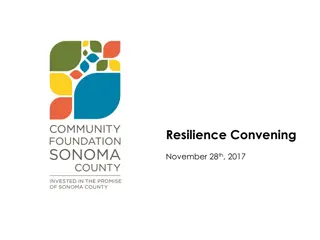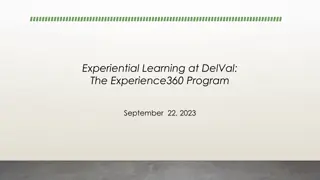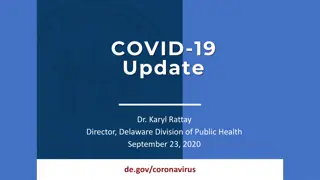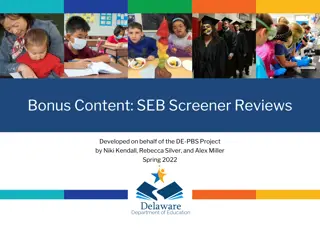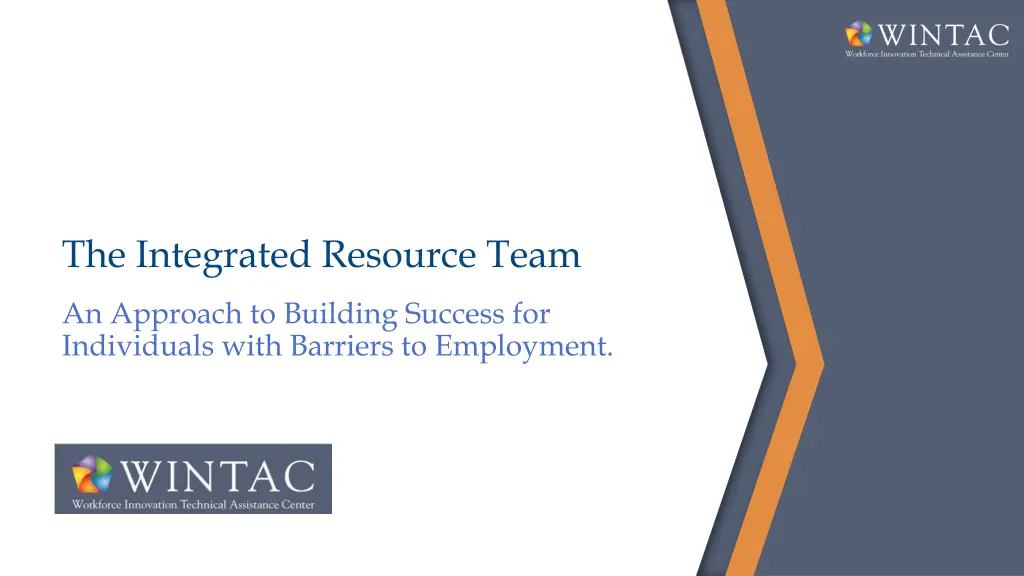
Building Success: Integrated Resource Team Approach for Employment Barriers
Explore the Integrated Resource Team (IRT) approach for individuals facing employment barriers. Learn how IRT aligns with Delaware Workforce System priorities, benefits customer service, and provides collaborative resources. Discover how to structure IRT meetings effectively.
Download Presentation

Please find below an Image/Link to download the presentation.
The content on the website is provided AS IS for your information and personal use only. It may not be sold, licensed, or shared on other websites without obtaining consent from the author. If you encounter any issues during the download, it is possible that the publisher has removed the file from their server.
You are allowed to download the files provided on this website for personal or commercial use, subject to the condition that they are used lawfully. All files are the property of their respective owners.
The content on the website is provided AS IS for your information and personal use only. It may not be sold, licensed, or shared on other websites without obtaining consent from the author.
E N D
Presentation Transcript
The Integrated Resource Team An Approach to Building Success for Individuals with Barriers to Employment.
Meet Your Facilitators Nikki Powis National Disability Institute (907) 957-4702 npowis@ndi-inc.org Sarah Loizeaux National Disability Institute (978) 621-4569 sloizeaux@ndi-inc.org 2
Objectives Understand the Integrated Resource Team (IRT) strategy and how it can be applied Understand how the IRT Strategy fits into the Delaware Workforce System priorities Recognize benefits of the IRT strategy for customer service Identify resources that will support collaborative teams in using the IRT strategy through the Community Academy Learn how to structure and conduct IRT meetings 3
Connecting the IRT to: 1: Delaware Workforce System Priorities 2: WIOA
Delaware Statewide Service Alignment Goals Adult Career Pathways Frontline Services Business Engagement Case Management Process Re-design
WIOA and the IRT WIOA Calls for streamlining of core programs, including the development of a Combined or Unified State Plan and cross-system/program common measures; and Calls for focusing services on targeted populations that have barriers to employment and for providing more wraparound services. The IRT Streamlines services through a cross-agency team approach; and Offers a tangible model for providing wraparound services based on the individual need of the job seeker to help the job seeker meet their employment goal (WIOA Common Performance). 6
WIOA and the IRT (continued) The IRT has many qualities that may make it an important and effective strategy for emerging WIOA service delivery models as it is a method of coordinating resources that is 7
Conceptualizing the IRT
The IRT Connection The Customer Medical Providers Financial Specialists Educators Job Developers Employers Housing Providers Transportation Providers Social Services Natural Supports Faith-Based Organization Case Managers/Counselo rs 10
Historical Background Born from the Disability Program Navigator (DPN) Initiative and its successor, the Disability Employment Initiative (DEI) Developed in response to the challenge of providing services across multiple systems based on the needs of an individual consumer Identified that customers often did not access all needed resources or received duplicative Recognized the need to address resource gaps based on an individual s needs Proved that through the IRT individual and systems level change could occur 11
What is an IRT? Initiated on behalf of a customer to address that individual s specific needs Brings together a team of diverse service providers to strategize how services can be coordinated to reach and maintain an employment goal Is an informal agreement between a customer and the systems providing services The customer and the team of service providers come together to establish three main components: Customer-identified, mutually agreed upon, employment goal Lines of Communication Sequence of Services. 13
Goals of the IRT Enhance cross-agency, cross-system collaboration and communication Collaboration makes everyone s job easier Promotes relationship building Allows the members to coordinate resources Customer driven approach - members of the team are based on the customer s unique needs Promotes shared accountability Share resources to address the needs of more people Shared outcomes across systems 14
What an IRT IS and What it IS NOT An IRT is an approach used for an INDIVIDUAL customer. An IRT is NOT an interagency committee consisting of various disability/community agencies that focus on systems collaboration. The main purpose of an IRT is EMPLOYMENT. The main purpose of an IRT is NOT resource mapping or to assist an individual to learn about various agency resources. 15
Who Participates in an IRT? An IRT may consist of members from a wide variety of community programs and service providers, including the following: The Workforce system Behavioral Health Vocational Rehabilitation Community Work Incentives Coordinator Employment Specialists Housing Provider School or Post Secondary Education Employer Correctional system - probation TANF Faith Based organizations Social Services Transportation services Apprenticeship sponsors Veterans Services Advocates/Friends of Job Seeker Others? 16
Developing Partnerships through the Community Academy
The Community Academy Strategy to Get to Know Your Partners Brings together a wide range of community partners traditional and non-traditional Builds relationships Develops cross agency team collaboration Promotes knowledge translation of all programs and resources Allows for brain storming of real customer issues Allows for same page understanding of the IRT and enhances by-in Enhances effectiveness of future work Enables understanding of one another's possibilities and limitations Produces out of the box thinking 18
Step 1: Career Exploration and Need As was noted in the previous section, the purpose of an IRT is to help the consumer attain their specific employment goal Career Exploration serves as the first step in developing an IRT. The career exploration should result in a proposed employment goal that is: Self-determined Strength-based Concrete enough to build a plan around Meets the required outcomes of the systems accessed. 21
Step 1: Career Exploration and Need (continued) Once the employment goal has been identified, consider the following: Employment Goal Are there resources and/or expertise beyond what is available from your own system that are critical to your customer s success in attaining the proposedemployment goal? The Customer What other systems is your customer currently accessing? Are there other systems that can help them attain and retain the proposed employment goal? 22
Step 2: Active Resource Coordination Active Resource Coordination (ARC) is the process of identifying needed resources and appropriate and prioritized action steps to address specific, targeted barriers to employment experienced by an individual customer. ARC is likely something you are already doing during the process of intake and plan development. Compared with the current service delivery model, this may just be an enhanced and more intentional step under the IRT approach. ARC is more than just a referral to multiple service providers. ARC is the process of helping the customer create a goal- specific (hint: employment goal) resource plan. 23
Step 2: ARC (continued) ARC is directly assisting a customer to convene and negotiate with multiple service providers to create an employment plan that accesses needed resources from multiple systems. Considerations when determining if your agency does active resource coordination include the following: Are referrals given before or after the development of an employment goal? Is communication between service providers solely the responsibility of the customer? Active Resource Coordination always takes place PRIOR to an Integrated Resource Team (IRT) being put in place, although active resource coordination may take place without resulting in an IRT. So you can have ARC without an IRT, but you CANNOT have an IRT without first having done some Active Resource Coordination! 24
Step 2: ARC vs. Simple Referral Active Resource Coordination is more than simple referral. As noted on the previous slide, it includes helping the customer to engage and approach partners around the potential for partnering with your agency. Many agencies will provide information and referral, but the customer may not understand the relevance of a referral or the steps that need to be taken. Active resource coordination helps the customer to identify, engage and coordinate resources around their needs relevant to achieving their employment goal. 25
Step 3: Building the IRT THREE ELEMENTS OF EVERY IRT MEETING The Team Led by the job seeker Professional support is only a facilitator Expertise and partnering is the key The Plan Not about the solution; about the puzzle Evolves Not tied to funding THREE ELEMENTS OF EVERY IRT MEETING The Individual Multiple needs/barriers Lack of coordination Stuck 26
Building the Team The Customer Medical Providers Financial Specialists Educators Job Developers Employers Housing Providers Transportation Providers Social Services Natural Supports Faith-Based Organization Case Managers/Counselo rs 27
Step 3: Who Should Be at the Table? The Employment Goal What resources beyond those available in your system are critical to your customer s success in attaining their employment goal? The Customer What system is your customer currently accessing? What services might your customer be eligible for that are relevant in the context of attaining their stated employment goal? 28
Step 3: Approaching Partners Before approaching partners, the customer should be engaged by your system and positioned to access your system s resources. For example Customer should be eligible or presumed eligible for your system s services. Customer should have determined an employment goal that allows for the application of your system s resources. Customer should be consulted and agree to all contacts, and have a clear understanding of the IRT approach and its benefits. 29
Step 3: Building the IRT - Partnerships Connect to partners based on individuals needs and service gaps Connect to services your customer is already involved in Determine what other services they need to connect to and invite If the customer needs to apply for services prior to attendance at the IRT, assist with the process Ask questions concerning the specific services that are being delivered. Emphasize the benefits of partnering with your program . Try to uncover areas where you or the partner have some flexibility within the established plans. 30
Step 3: Building the IRT -- Convening the meeting Once the customer is determined eligible by another service provider, and these service providers are agreeable to partnering, discuss with your customer their role as the driving member of the Integrated Resource Team. After establishing the customer s role, a face-to-face meeting should be convened -- whenever possible -- with the partners and the customer. If a face-to-face meeting is not possible, virtual meetings are adequate. The purpose of the meeting is to reach consensus around the following three key parameters: 1. A common employment goal 2. Lines of Communication 3. A Sequence of Services 31
Considerations and Plan Negotiation
A Quick Review: Active Resource Coordination is the process in which you help customers identify resources, that are beyond what your own program can provide, and help to engage those resources around a mutually agreed upon employment goal. Following Active Resource Coordination, an IRT meeting is convened with the customer and partner agencies in which (led by the customer) the customer and agencies come to consensus around three key parameters: Employment Goal Lines of Communication Sequence of Services Customers and Partners agree to roles and services consistent with their own agencies allowances and plans are documented and moved forward. 33
IRT Considerations Based on your customer s work goal and listed challenges, determine the following: What types of people, supports, resources does this individual need to reach their goal? With this information, who should participate in this individual s IRT? Which agencies/individuals would contribute to the success of this individual? Who or what natural or other supports should be at the table? Who will be the most productive advocate or mentor for this individual to assist with attaining their goals? 34
IRT Considerations (continued) Set up your IRT for success and sustainability Which agency would be the best fit to provide the leadership/coordination for the IRT? What role will each member of the team play? Who is responsible for what and when? How and when will the team communicate with the customer? With one another? Do you have a plan for supporting crises or roadblocks? Do you have equal resource sharing (time and financial), and do you have full buy-in from everyone? Does the individual have responsibility and buy-in? Who will ensure forward momentum? Do you have a plan for continuation beyond program exit? 35
Recapping the Benefits of the IRT
The Benefits of an IRT Win-Win (Slide 1 of 3) The IRT approach is individualized and promotes active involvement and accountability of all team members. IRT members and services are dynamic, providing flexible and timely services and supports that are adjusted in response to the changing needs, preferences or life situations of the individual as they move through the employment process. The IRT is a Team Approach, ensuring a holistic response, providing a full complement of needed services for the individual. The IRT leverages existing resources to improve coordination and avoid duplication of services. Active Resource Coordination can provide the vehicle for agencies to come together and provide stabilization services to prepare an individual to develop an employment goal prior to participating in the full IRT services. The Teamwork established within the IRT alleviates a heavy load on any one person or agency. 37
The Benefits of an IRT Win-Win (Slide 2 of 3) The IRT can designate a member to maintain documentation of services and progress that can be replicated through copy/paste and entered into each agency s separate MIS systems, thereby cutting down on documentation burden. Assessment documents can be shared so all agencies get the same information as needed. The IRT promotes accountability and follow-through for both individual and service providers. The IRT can provide a single point of contact for the individual with lines of communication being established as a mechanism to keep all members informed. The IRT can happen anywhere providing ease of access for the individual to their service team. 38
The Benefits of an IRT Win-Win (Slide 3 of 3) The IRT can establish complimentary services and increase practitioner s knowledge of other service delivery options. Team members can establish a common mission that respects individual agency s criteria for services and allows each agency to contribute their strength to create a whole of the parts. The IRT is empowering for the individuals as they see how many people they have supporting and encouraging them to achieve their goals. Lines of communication are established to include a common understanding of individual agency terms and definitions. The IRT provides a mechanism for sharing costs, resources and can establish common goals for the individual that can be replicated on each agency s individualized plan. The IRT builds relationships between agency staff and the individuals they serve. 39
The Emerging IRT Pilot in Delaware Led by Delaware Division for the Visually Impaired (DVI) Pilot location identified Training for staff completed Specific counselors identified DVI is working on the internal structure and developing an organized list of available resources/service providers currently For more information contact: Jamie Towns Phone (302) 255-9822 jamie.towns@delaware.gov 41
Resources Success Stories in Utilizing an Integrated Resource Team February 2018 (Iowa) https://www.youtube.com/watch?v=CYuWjYKgZdI Integrated Resource Team Portland Oregon https://vimeo.com/260033830 Workforce Innovation Technical Assistance Center (WINTAC) http://www.wintac.org Archived training on IRT Site registration required http://lms.wintac.org/course/view.php?id=68 42
Questions 43

